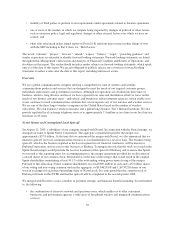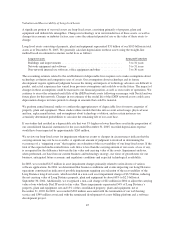Sprint - Nextel 2005 Annual Report Download - page 55
Download and view the complete annual report
Please find page 55 of the 2005 Sprint - Nextel annual report below. You can navigate through the pages in the report by either clicking on the pages listed below, or by using the keyword search tool below to find specific information within the annual report.Revenues consist of fixed monthly recurring charges, variable usage charges, equipment charges, miscellaneous
fees such as activation fees, directory assistance, operator-assisted calling, equipment protection and late
payment charges, and certain regulatory fees. We recognize operating revenues as services are rendered or as
products are delivered to customers in accordance with Staff Accounting Bulletin No. 104, Revenue Recognition,
and Emerging Issues Task Force, or EITF, Issue No. 00-21, Revenue Arrangements with Multiple Deliverables.
We recognize revenue for access charges and other services charged at fixed amounts ratably over the service
period, net of credits and adjustments for service discounts, billing disputes and fraud or unauthorized usage. We
recognize excess usage and long distance revenue at contractual rates per minute as minutes are used. As a result
of the cutoff times of our multiple billing cycles each month, we are required to estimate the amount of
subscriber revenues earned but not billed from the end of each billing cycle to the end of each reporting period.
These estimates are based primarily on rate plans in effect and our historical usage and billing patterns, and
represented less than 10% of our accounts receivable balance as of December 31, 2005.
Certain of our bundled-products and services, primarily plans for our Wireless segment, are considered to be
revenue arrangements with multiple deliverables. Total consideration received in these arrangements is allocated
and measured using units of accounting within the arrangement based on relative fair values. We classify revenue
from sales of handsets as equipment revenue. We recognize revenue from handset sales when title to the handset
passes to the dealer or end-user customer.
Wireless offerings include wireless phones and service contracts sold together in our company-operated stores.
The activation fee revenue associated with these direct sales channels is recognized at the time the related
wireless phone is sold, and is classified as equipment sales. Wireless activation fees earned prior to the 2003
adoption of EITF Issue No. 00-21 are being deferred and amortized over the estimated average life of the end
user customer.
Certain activation fees associated with unbundled sales in our wireless segment are deferred and amortized over
the estimated average life of the end-user customer. We defer the recognition of certain installation fees related to
services provided by our Local segment and recognize the revenue over the estimated average life of the
customer.
We establish an allowance for doubtful accounts receivable sufficient to cover probable and reasonably estimable
losses. Because of the number of accounts that we have, it is not practical to review the collectibility of each
account individually when we determine the amount of our allowance for doubtful accounts each period. Our
estimate of the allowance for doubtful accounts considers a number of factors, including collection experience,
current economic trends, estimates of forecasted write-offs, aging of the accounts receivable portfolios, industry
norms, regulatory decisions, and other factors. If our allowance for doubtful accounts estimate at December 31,
2005 were to change by ten percent, it would represent a change in bad debt expense of $20 million for the
Wireless segment and $6 million each for the Long Distance and Local segments.
The accounting estimates related to the recognition of revenue and the allowance for doubtful accounts in the
results of operations require us to make assumptions about future billing adjustments for disputes with customers,
unauthorized usage, future returns on asset sales and future access adjustments for disputes with CLECs and
inter-exchange carriers, as well as the future economic viability of our customer base.
Management believes the allowance amounts recorded, in each instance, represents its best estimate of future
outcomes, but the actual outcomes could differ from the estimate selected, and the impact that changes in actual
performance versus these amounts recorded would have on the accounts receivable reported on the balance sheet
and the results reported in the statements of operations could be material to our financial condition.
44
























